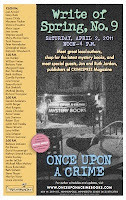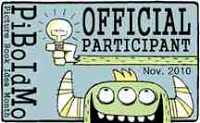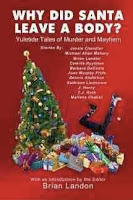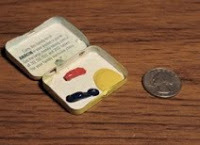Barbara DaCosta's Blog, page 6
December 8, 2011
When is a Picture Book Not Just a Picture Book? Ed Young's The House Baba Built
 This beautiful book captures author-illustrator Ed Young's life in Shanghai during World War II. He tells a story that will captivate young and old alike, a story that functions on many levels. Most touchingly, it is a tribute to his father, whose concern for his family led him to build the house, and whose message to his children has been carried out in Ed Young's numerous books over the past fifty-some years.
This beautiful book captures author-illustrator Ed Young's life in Shanghai during World War II. He tells a story that will captivate young and old alike, a story that functions on many levels. Most touchingly, it is a tribute to his father, whose concern for his family led him to build the house, and whose message to his children has been carried out in Ed Young's numerous books over the past fifty-some years.The message is basically this: Do good work.
Ed Young can be seen in this BBC video, discussing the book, its meaning, and how it was made.
Published on December 08, 2011 19:59
July 18, 2011
Plagued by Plot?—Try Logic!
 How do writers deal with plotting? And how do they deal with being stuck with the plot? Find out what these squiggles to the left mean and how they can help solve the most intractable plot problem in my essay at the blog Buried Under Books.
How do writers deal with plotting? And how do they deal with being stuck with the plot? Find out what these squiggles to the left mean and how they can help solve the most intractable plot problem in my essay at the blog Buried Under Books.
Published on July 18, 2011 09:14
April 16, 2011
Supersize Me—Organic Style
 "Super-apple" ©2011 B. DaCostaIf an apple a day keeps the doctor away, then what do we make of organic super-apples? Here are two apples that I bought on my quest for an apple a day. No wonder that I barely had an appetite for dinner after eating the one on the left! By my calculations, it had three times as much volume as the smaller one, which was what I consider to be a standard lunch-box size.
"Super-apple" ©2011 B. DaCostaIf an apple a day keeps the doctor away, then what do we make of organic super-apples? Here are two apples that I bought on my quest for an apple a day. No wonder that I barely had an appetite for dinner after eating the one on the left! By my calculations, it had three times as much volume as the smaller one, which was what I consider to be a standard lunch-box size. It used to be that "organic" meant getting something that might not be cosmetically perfect, not plumped out with fertilizers or hormones, yet safe and scrumptious. Now, however, organics have become big business, and with that has come the possibilities shown here: perfectly shaped, perfectly sized, perfectly colored, and, as with the apple on the left, as perfectly super-sized as any commercial apple crop might be.
Published on April 16, 2011 10:22
March 26, 2011
Intricacies of Life
 Everything in life is interconnected. They say a butterfly's wing beating can create an effect across the world. All the more so a wave in the ocean. Not only the force of the wave as it travels, but the thousands of big and littles ways that the wave and its aftermath touches the lives of so many. A picture of a boat on the roof of a building, amidst absolute desolation. How does one move a ship off a building? How does one start to clean up?
Everything in life is interconnected. They say a butterfly's wing beating can create an effect across the world. All the more so a wave in the ocean. Not only the force of the wave as it travels, but the thousands of big and littles ways that the wave and its aftermath touches the lives of so many. A picture of a boat on the roof of a building, amidst absolute desolation. How does one move a ship off a building? How does one start to clean up?
Published on March 26, 2011 17:29
February 14, 2011
Ninth Annual Write of Spring at Once Upon a Crime
 Don't ask me how they do it, cramming a dozen mystery writers and fans and books galore per hour into a tiny space. Somehow Pat and Gary at Once Upon a Crime manage to do it every year. So much so, that they are this year receiving the Mystery Writers of America's Raven Award for service.
Don't ask me how they do it, cramming a dozen mystery writers and fans and books galore per hour into a tiny space. Somehow Pat and Gary at Once Upon a Crime manage to do it every year. So much so, that they are this year receiving the Mystery Writers of America's Raven Award for service.Independent bookstores like this, feed on an ongoing basis, the thirst of many a reader, and help maintain the fabric of our communities. The staff has read practically every mystery under the sun, they know what else you might enjoy, and they provide a warm atmosphere in which to explore your literary tastes. As a Publishers Weekly Shelftalk blogger just wrote, "We [bookstores] want to the store to be a place you come in when you're sad and need to smell the books to feel better or get a hug from someone who is sad that you're having a terrible day. We want to be the store you can call at closing and we'll leave a book you need for a present on the doorknob for you to pick up after work .... We pay sales and property taxes that fund the schools, the roads, and the Little League field and we're happy to do it. We bring authors to the schools and host wonderful, free events for the whole community. We need you as much you need us."
Once Upon a Crime is just one of the many bookstores that fit this bill (and the Twin Cities is lucky to have many good bookstores of all stripes, including chains). They support authors, and we authors like to support them, in return, through events such as this.
This year, I'll be appearing with just a few of my mystery-writer buddies---forty-nine, to be exact--- Saturday, April 2, 2011, from 12–4 pm. Once Upon a Crime is located at 604 West 26th Street (near Lyndale Avenue South) in Minneapolis. Among some of the authors appearing: Monica Ferris, Laura Childs, Susan Runholt, Mary Logue, Steve Thayer, and many more. Here's the link to the store.
We'll be happy to see you!
Published on February 14, 2011 13:05
January 18, 2011
Fact-checking is Good
 It's never too early to start fact-checking. While working on a children's story about Duluth, I paused to check a couple of facts about Duluth's iconic Aerial Lift Bridge. I began with using the great online resource of the Minnesota Historical Society, and local resources such as the Duluth Public Library and the wonderful Lake Superior Maritime Museum. These led me to talk to Tony Dierckins, author of Crossing the Canal: An Illustrated History of Duluth's Aerial Bridge and read his fabulous book.
It's never too early to start fact-checking. While working on a children's story about Duluth, I paused to check a couple of facts about Duluth's iconic Aerial Lift Bridge. I began with using the great online resource of the Minnesota Historical Society, and local resources such as the Duluth Public Library and the wonderful Lake Superior Maritime Museum. These led me to talk to Tony Dierckins, author of Crossing the Canal: An Illustrated History of Duluth's Aerial Bridge and read his fabulous book.The bridge is the centerpiece of Duluth's tourist attractions. Until the harbor freezes up each winter (the lake is so big that it doesn't freeze except along the shore), the bridge goes up and down many times each day—halfway up for the Vista Queen and other tall-masted craft. When the big shiphorns do their salute and the bridge goes up all the way, the crowds gather to see the huge oreboats and "salties" come through the canal.
These days, the bridge is commonly called the "Lift Bridge." My research taught me that one should, however, never make assumptions. If you look closely at this photo, maybe you can see what I mean.
Detail of postcard from c. 1910, Minnesota Historical Society collection.
Published on January 18, 2011 08:52
November 10, 2010
November is Novel Writing--no, Picture Book Idea, no...


It's November, and I'm caught in the middle! Do I participate in National Novel Writing Month (NaNoWriMo), or one of its many spin-offs such as Picture Book Idea Month (PiBoIdMo)?? Do I write 50,000 words in a month (in my dreams!) for Nano, or a few thousand for PiBo? Do I want to write for adults, or for children? Do I make flow charts of plots, or sketches of goofy monsters? Or do I simply go with the coolest web badge?
Published on November 10, 2010 18:41
November 9, 2010
You know how when you walk into some people's houses, you...
 You know how when you walk into some people's houses, you feel like you know who they are? Their personalities, values, and how their minds work? Have you ever had that feeling about computer software?
You know how when you walk into some people's houses, you feel like you know who they are? Their personalities, values, and how their minds work? Have you ever had that feeling about computer software?I certainly have. For years, I've tussled with writing with word-processing programs: scrolling for miles, searching for key points, cutting and pasting sections, bracketing reminder notes to myself, losing or confusing drafts, and scribbling notes on printouts. Other programs had arcane, convoluted, and confusing internal logic with oddly named functions, and constantly crashed.
So, when I stumbled across Scrivener a few years ago, it felt like putting on an old glove. Developed by a writer for writers, it captures all of the various tasks that a writer does in creating a work, long or short, straightforward or complex. But not abstract tasks jerry-rigged and patched into a program, but rather organically grown out of actual writers' needs, and structured in ways that are sensible to a writer. Where do I file this research note, this website reference, this character trait, this audio interview? Can I subdivide this chapter? Can I meld three scenes together from different chapters? Can I jump from section to section? What reference styling will I need for my notes? Can I automate screenplay styling? Comic books? Novels? Theses? Can I label and color-code and make index cards and customize output?
Scrivener meets these needs and more.
I write about Scrivener not as an advertisement for it, but because for many people, it will feel like a lifesaver. It is insanely cheap, and the user forums (on which the designer participates) are informative, civil, and helpful. A real community has been created that has endured even as the software has matured and become a real company. The new manual and tutorials are thorough. The popularity of this program among writers has been such that people have switched from PC to Mac in order to use it. But now, the developers have surprised everyone and in addition to a new Mac release (Scrivener 2.0) they've come out with a Windows version.
Scrivener deserves high accolades.
Not bad for an old glove.
Published on November 09, 2010 06:31
October 5, 2010
DaCosta New Story Published
 "As the Number 18 bus pulled up, Terrence stuck his weather-beaten hands back into his pockets to warm them for a brief moment. He hated panhandling, but with a bum back and bum eye, there wasn't much work he could get."
"As the Number 18 bus pulled up, Terrence stuck his weather-beaten hands back into his pockets to warm them for a brief moment. He hated panhandling, but with a bum back and bum eye, there wasn't much work he could get."In this story, "For Want of Some Gloves," I tackle the layers of honesty, thievery, and assumptions that so easily can creep into our lives. The story appears in Why Did Santa Leave a Body, a collection of holiday season mysteries now available from North Star Press. Edited by Brian Landon, the book also features stories by Jessie Chandler, Michael Allan Mallory, Brian Landon, Camille Hyytinen, Joan Murphy Pride, Dennis Anderson, Kathleen Lindstrom, J. Henry, T.J. Roth, and Marlene Chabot. ---Barbara DaCosta
Published on October 05, 2010 20:59
September 20, 2010
The World's Tiniest Watercolor Kit
 Writers distract themselves by doing crossword puzzles, making labels for file folders, and by sharpening pencils. Artists, on the other hand, are quite unique and distract themselves by doodling, sorting art supplies, and by sharpening pencils. Some painters go over the deep end spending hours preparing convenient and functional travel kits for trips or outdoor work. Since the invention of Fimo clay, painters have used Fimo to make paint wells to fit in metal boxes such as those from Altoid Mints or Sucrets. In fact, there's a whole underground culture online about creating these kits.
Writers distract themselves by doing crossword puzzles, making labels for file folders, and by sharpening pencils. Artists, on the other hand, are quite unique and distract themselves by doodling, sorting art supplies, and by sharpening pencils. Some painters go over the deep end spending hours preparing convenient and functional travel kits for trips or outdoor work. Since the invention of Fimo clay, painters have used Fimo to make paint wells to fit in metal boxes such as those from Altoid Mints or Sucrets. In fact, there's a whole underground culture online about creating these kits. I found an even smaller and easier method: dispense with the Fimo, and use a box that already has an acceptable interior paint job. I found the perfect one in the junk drawer. The only drawback with not having paint wells is that the paints mingle some as they're used, which is not to everyone's taste.
I found an even smaller and easier method: dispense with the Fimo, and use a box that already has an acceptable interior paint job. I found the perfect one in the junk drawer. The only drawback with not having paint wells is that the paints mingle some as they're used, which is not to everyone's taste. For my mini-kit, I only needed to cover the box edges with clear tape (unlike the Altoids boxes, this one has no "lip"), so that my brushes wouldn't get damaged.
This amount of paint kept me and three kids in business painting to our hearts' content for almost an hour. Not that I was wasting time distracting myself, you understand.
Published on September 20, 2010 18:57



